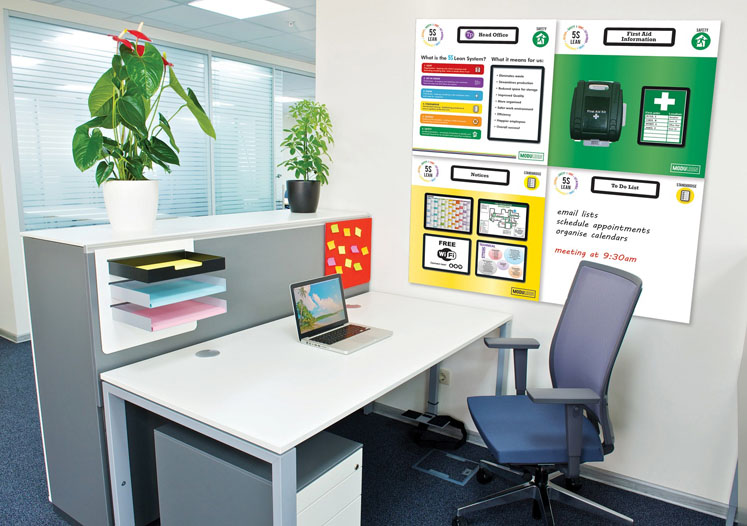High levels of safety, security and organisation have to be paramount when it comes to the working environment. Meeting the demand for shadow and impactful visual communication boards as companies strive for 5S compliance and lean operations in the workplace will contribute significantly to ensuring this.
Any effective workplace, from an office to the factory shop floor, from the warehouse and logistics centre to high street store, benefits from a reliance on visual cues and communication to operate efficiently and safely.
The advantage of visual workplaces can drive heightened levels of quality, productivity, safety and employee morale. Moreover, visual aids subliminally feed people with the information they need by answering questions, identifying equipment and describing procedures. They also provide important safety information. And that’s one reason why we are seeing increasing numbers of organisations implementing their 5S programmes.
Developed in Japan, and embodying orderliness, standardisation and cleanliness among other attributes, 5S is an inexpensive management approach that has at its heart a system of visual aids and tools.
These are designed to help employees positively contribute to the organisation they work in, driving improvements and advantages across the whole business environment. Enshrined in the 5S concept are sort, set, shine, standardisation and sustain.
5S itself can be subject to continuous improvement, so the adoption of shadow boards for tools and specialist equipment, will provide a common sense — and more cost effective — way to improve the organisation of the workplace, as part of the overall adoption of lean processes.
Elimination of waste
Who wouldn’t disagree that the elimination of wasteful practices has to be an important consideration in business? So, nullifying the effect of unnecessary actions can add value and cut costs in straightened times. Shadow boards are a proven means to implement continuous improvement principles because they are designed to encourage smarter working practices and drive out waste.
Misplacing workplace equipment can be frustrating, inconvenient and inefficient. It is so often the case that it is not until work is under way and people are reaching for a specific item, that they realise it has gone missing. They will inevitably have to then stop what they are doing and waste valuable time and effort attempting to locate the item — or if they are unable to find it, spend needlessly to replace it.
Experience has revealed that visual solutions have been found to be more effective than any other communication medium, even in distracting environments.
When introduced into the workplace, the impact and advantage of shadow boards can be manifold. Equipment can be arranged in a logical position and handy locations, making them immediately visible and anything that is amiss – a missing brush, for instance - can be instantly identified and rectified before other people become involved.
Shadow boards can be seen as an embodiment of a common-sense approach to an effective style of law and order in the workplace. Shadowing products (or equipment) has proven to be effective in helping people to find the right device quickly and efficiently.
Usage instructions suitably indicated alongside serve as a subtle reminder every time the device is used. It is, however, important to use shadow boards with colours and artwork best suited to the visibility levels in the workplace.

Colour coded, they can create standardisation, personalisation and effective delineation to ensure that the right equipment is always available, in the right place at the right time. Users can also reduce operational costs as workplace standardisation removes the requirement for designing and installing expensive and time-consuming custom-made shadow boards.
No one can afford to be complacent when it comes to workplace efficiency, regardless of the operational environment.
It’s clear that higher visibility of tools and more effective management of them is an important asset to staying in step with 5S lean processes. Specifically designed to ensure compliance with lean processes, they can help to unlock higher productivity levels in the workplace.
Ease of location due to clear product marking provides rapid identification of equipment in a busy, cluttered industrial shop floor or warehouse, enhancing production levels and reducing errors, while minimising the possibility of cross-contamination in hygiene areas.
Undoubtedly, shadow boards can also transcend the testing environments of today’s workplace. Although a hard copy of instructions has a short life, is difficult to refer and needs multiple prints for distribution, details featured on shadow board systems are here to stay, unless there are additions or deletions to the set of devices.
Multiple transparent pockets can hold hard copies of processes/instructions, with changes updated by simply replacing an older copy with the latest details. These are but a few salient benefits of the shadow board system. Adopting the right design will help make best of this visual solution.
Different workplaces
It’s important to recognise that each workplace is different: it has its own particular set of unique requirements concerning tool organisation and management.
And this must be reflected in any solution involving shadow boards. So, a visualisation strategy must be tailored to suit individual needs and requirements – the ones size fits all won’t always work in an environment in which the optimum flow of productivity is critical.
Workplaces, large or small, require a good deal of complex planning and product support, so think about your visualisation investment in terms of quality, reliability and performance.
Consider also how your supplier can add value through bespoke planning and consultancy services. The implementation of standardised shadow boards can be an innovative, cost-effective and time-saving investment, meeting the demand for impactful visual communication boards as companies comply with 5S and Lean in the workplace.
